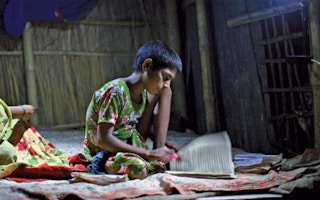In the lead up to the UN General Assembly, the Skoll World Forum partnered with Johnson & Johnson, the United Nations Foundation and the Bill and Melinda Gates Foundation to produce an online debate focused on the last 850 days before the MDGs expire in 2015. We asked some of the world’s leading experts what is one thing we must do differently or better to achieve MDGs 4, 5 and/or 6—all focused on improving public health—by the deadline? View the full series here.
Millions of people in our world today live in abject poverty, in part because they lack access to modern energy services. In Africa alone, 80 per cent of the continent’s population continues to use traditional biomass for cooking and heating purposes. In Sub-Saharan Africa, only 31 per cent have access to electricity.
As a young man growing up in Sierra Leone, I studied by candlelight. Today, 31 years after my undergraduate education at Njala University College, the problem persists not only in Sierra Leone but around the world. Indeed, without access to energy, a country or community cannot achieve the Millennium Development Goals. Sustainable energy is essential to sustainable development.
On a recent trip to my village of Kychum in Northern Sierra Leone, I was sitting outside and chatting with neighbours when I noticed a woman arriving by boat. I saw the woman pick up wood and put it on her head. What was striking was that she was also pregnant and carrying a two-year-old on her back.
“
Access to modern energy services, lighting, refrigeration, and clean water is essential for social and economic development in nearly every sector; in health care, it is more than that – it can mean the difference between life and death.
A few days later, I talked to a young woman who had given birth at home in the dark, instead of at the health clinic. When I asked her why, she said that the clinic had no electricity, and she didn’t have the money to buy a candle. For many women around the world, this is the reality.
Access to modern energy services, lighting, refrigeration, and clean water is essential for social and economic development in nearly every sector; in health care, it is more than that – it can mean the difference between life and death.
In 2011, UN Secretary-General Ban Ki-moon launched a global initiative to achieve three ambitious goals by 2030: ensuring universal access to modern energy services, doubling the global rate of improvement in energy efficiency, and doubling the share of renewable energy in the global energy mix. The General Assembly recently declared a UN Decade of Sustainable Energy for All, to begin in 2014.
The global community has rallied particularly around the MDGs of improving maternal health and reducing child mortality. Energy is a critical enabler for primary health care services, especially maternal and childbirth emergencies, yet around the world, hot spots of mortality and disease closely match areas where health facilities lack electricity for lighting, medical equipment, and mobile communication.
Lack of pumped water, along with fuels for boiling it to sterilize equipment or provide the basic sanitary conditions to support health services, further undermines the ability to fight infant and maternal deaths. According to the World Health Organization (WHO), in 2010 an estimated 287,000 women worldwide died of complications from pregnancy and childbirth; the vast majority of these deaths could be averted by providing quality health services.
At the community level, a lack of energy at medical clinics impedes the ability of medical personnel to provide adequate treatment and care. Reliable electricity is needed for everything from lighting to equipment sterilization, powering essential medical equipment for diagnostic and treatment purposes, and storage of vaccines – yet in some Sub-Saharan African countries, a quarter to a half of all health care facilities have no electricity, and most facilities that do have electricity suffer chronic outages and shortages.
The energy and health nexus is not limited to clinics. Globally, 1.3 billion people still lack access to electricity, and the poor often pay the most as a proportion of their household income for inadequate, dangerous, and unhealthy energy sources that kill many women and children prematurely. Some 2.7 billion people depend on dirty and dangerous sources of fuel for lighting, heating, and cooking. Smoke inhalation leads to millions of avoidable deaths annually through respiratory illnesses like pneumonia. Simply collecting firewood puts women and girls at risk of attack and rape. They are also deprived of their basic right to a decent education: We know that without access to light, they simply cannot study.
To support women’s health, the Sustainable Energy for All initiative is focusing initially on providing clinics with electricity for lighting and other energy-dependent health services, in an effort led by the World Health Organization (WHO), the United Nations Foundation, UN Women, the World Bank, and interested corporate and NGO partners, working closely with governments. This collaborative multi-stakeholder approach will support policies and investment to accelerate assessment and deployment, particularly through market-based approaches, for modern energy services.
Access to energy spurs development on many levels – creating new markets to drive economic growth, improving social equity, and protecting the environment for a healthier, more sustainable future. A focus on energy and women’s health will bring stakeholders together to address the MDGs on reducing child mortality and improving maternal health in a tangible, scalable, and sustainable way. We encourage you to join us in supporting this critical work.
Kandeh K. Yumkella is the special representative of the Secretary-General on Sustainable Energy for All and chief executive officer of Sustainable Energy for All. This post originally appeared here.










